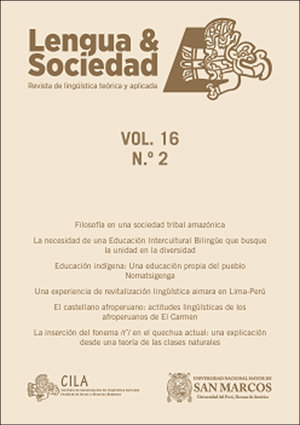The /rˇ/ phoneme insertion in current Quechua: an explanation from a theory of natural classes
DOI:
https://doi.org/10.15381/lengsoc.v16i2.22378Keywords:
Quechua phonology, multiple vibrant phoneme, natural classes and subclasses, natural classes theoryAbstract
The present study brings a possible explanation of how vibrant multiple prepalatal /ř/ is a «natural» segment in consonantal inventory of current Quechua despite its evident derivation from the contact with Spanish. In other words, the phoneme /ř/ has been incorporated into the phonological system of some dialects of Quechua and it is in process of expansion to all dialects, due mainly to its correspondance to a «natural» slot within the Quechua system rather than a merely loan explanation or an interference of the Andean Spanish. In any case, without neglecting any of the given explanations, I propose that the determinant factor is intrinsic to the phonological system of Quechua from the point of view of a natural classes theory. Because of this theory, Quechua consonantal system is organized into natural classes, where [+cons, +cor] class is nuclear. Within this natural class there is an opposition between two subclasses: [+cons, +cor, +ant] / [+cons, +cor, +post]. The presence of the multiple retroreflex vibrant would be explained by their relocation in the second subclass where it fullfills an empty cell.
References
Alonso-Cortés, Á. (2002). Lingüística. Madrid: Cátedra.
Bisol, L. (Org.). (2005). Introdução a estudos de fonología do português brasileiro (4.ª ed.). Porto Alegre: EDIPUCRS.
Campbell, L. (1999). Historical Linguistics: An Introduction. Massachusetts: Massachusetts Institute of Technology.
Cerrón-Palomino, R. (1976). Gramática quechua Junín-Huanca. Lima: Instituto de Estudios Peruanos - Ministerio de Educación del Perú.
Cerrón-Palomino, R. (2003). Lingüística quechua. Cusco: C. E. R. A. «Bartolomé de las Casas».
Coombs, D. et al. (1976). Gramática quechua San Martín. Lima: Instituto de Estudios Peruanos - Ministerio de Educación del Perú.
Cusihuamán, A. (2001). Gramática quechua Cuzco-Collao. Cusco: C. E. R. A. «Bartolomé de las Casas».
Flemming, E. (2005). Deriving natural clases in phonology. Lingua, 115(3), 287-309. doi:10.1016/j.lingua.2003.10.005
Morales, A. (1992). Teorías delosrasgosdistintivos. ASJU, 26(2), 613-643. Recuperado de https://www.ehu.eus/ojs/index.php/asju/article/viewFile/8309/7471
Parker, G. (1965). Gramática del quechua ayacuchano. Lima: Universidad Nacional Mayor de San Marcos.
Parker, G. (1976). Gramática quechua Áncash-Huailas. Lima: Instituto de Estudios Peruanos - Ministerio de Educación del Perú.
Quesada, F. (1976). Gramática quechua Cajamarca-Cañaris. Lima: Instituto de Estudios Peruanos - Ministerio de Educación del Perú.
Quesada, F. (2006). Quechua de Cajamarca. Morfología. Fonología. Sintaxis. Lima: Mantaro.
Soto, C. (1976). Gramática quechua Ayacucho-Chanca. Lima: Instituto de Estudios Peruanos - Ministerio de Educación del Perú.
Taylor, G. (1996). El Quechua de Ferreñafe. Cajamarca: Acku Quinde.
Downloads
Published
Issue
Section
License
Copyright (c) 2017 Norma Meneses Tutaya

This work is licensed under a Creative Commons Attribution 4.0 International License.
AUTHORS RETAIN THEIR RIGHTS
a. Authors retain their trade mark rights and patent, and also on any process or procedure described in the article.
b. Authors can submit to the journal Lengua y Sociedad, papers disseminated as pre-print in repositories. This should be made known in the cover letter.
c. Authors retain their right to share, copy, distribute, perform and publicly communicate their article (eg, to place their article in an institutional repository or publish it in a book), with an acknowledgment of its initial publication in the journal Lengua y Sociedad.
d. Authors retain theirs right to make a subsequent publication of their work, to use the article or any part thereof (eg a compilation of his papers, lecture notes, thesis, or a book), always indicating its initial publication in the journal Lengua y Sociedad (the originator of the work, journal, volume, number and date).






